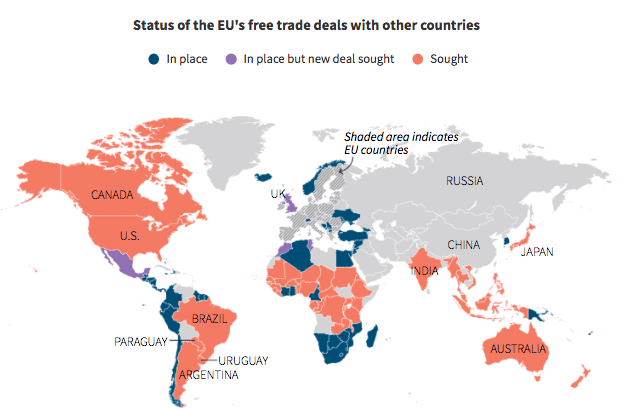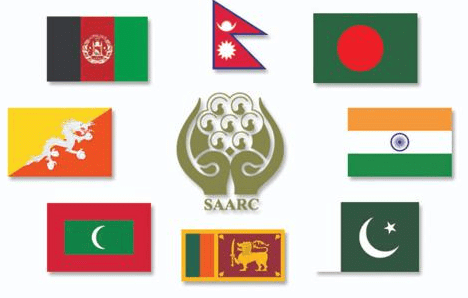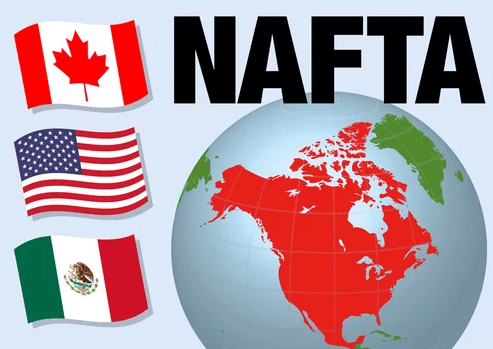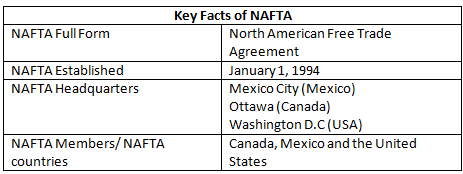European Union, ASEAN, SAARC & NAFTA | Crash Course for UGC NET Commerce PDF Download
| Table of contents |

|
| EU Trade Agreements Overview |

|
| ASEAN Meaning and Objectives |

|
| SAARC Meaning |

|
| North American Free Trade Agreement (NAFTA) |

|
EU Trade Agreements Overview
The European Union (EU) stands as one of the world's largest trading blocs, maintaining numerous trade agreements with countries and regions globally. These agreements aim to foster free and fair trade by reducing or eliminating tariffs and non-tariff barriers. They also encompass areas such as services, intellectual property, government procurement, competition, and sustainable development. The EU’s extensive network of trade agreements provides European businesses with access to global markets, contributing to economic growth and job creation across Europe.
EU Trade Deals

The EU operates as a political and economic union of member states primarily located in Europe, with international trade being a central aspect of its activities. The EU negotiates trade agreements with countries and regions worldwide to facilitate the exchange of goods, services, and investments. The specifics of these trade agreements can vary depending on the negotiation context and the parties involved. For the most up-to-date information on current EU trade deals, including new agreements or updates, it is recommended to consult official sources such as the European Commission’s website or relevant government authorities within EU member states. Additionally, news sources and official EU press releases provide updates on the latest developments in EU trade agreements.
Types of EU Trade Agreements
The EU's trade agreements can be categorized into three main types:
EU Free Trade Agreements: These comprehensive agreements aim to eliminate nearly all tariffs and barriers to trade with partner countries such as South Korea, Canada, and Japan. Notable examples include the EU-South Korea Free Trade Agreement and the EU-Canada Comprehensive Economic and Trade Agreement (CETA).
EU Association Agreements: These agreements establish a broad political and economic association with partner countries, including a free trade area to liberalize trade in goods and services. They also cover areas such as energy cooperation, environmental protection, migration, and foreign policy dialogue. Examples include the EU-Ukraine Association Agreement and the EU-Moldova Association Agreement.
EU Trade Partnership Agreements: These are lighter agreements focused on developing trade and economic relations without establishing a broad association. An example is the EU-Mercosur Trade Partnership Agreement, which is currently under negotiation.
Benefits of EU Trade Agreements
Key benefits of EU trade agreements include:
- Tariff Reductions: Lowering or eliminating tariffs on goods traded between the EU and its partners, making EU exports more competitive and reducing the cost of imports.
- Increased Trade Flows: Opening markets to boost the trade volume in goods and services between the EU and its trading partners, leading to significant increases in trade over time.
- Greater Consumer Choice and Lower Prices: With increased trade and competition, consumers benefit from a wider range of products and often lower prices.
- Economic Growth: Expanding trade ties promotes specialization, increases competition, and facilitates the transfer of knowledge and technology, all of which drive economic growth.
- Geopolitical Influence: Trade agreements allow the EU to strengthen economic ties with strategic partners and enhance its influence on the global stage.
EU Trade Cooperation Agreements
The EU also establishes Trade Cooperation Agreements with certain partners to develop closer trade and economic ties without creating a broad political association, as seen in Association Agreements. These agreements primarily focus on:
- Tariff Reductions: Reducing or eliminating tariffs on specific goods, making trade in these products duty-free or subject to lower taxes, which benefits European businesses and consumers.
- Market Access for Services: Allowing EU service providers to access the partner's market, and vice versa, in sectors such as banking, insurance, e-commerce, and telecommunications.
- Cooperation on Technical Standards: Promoting cooperation on technical regulations, standards, and conformity assessment to simplify market access for EU companies.
- Strengthening Legal and Policy Frameworks: Enhancing intellectual property rights, public procurement, competition policies, and sustainable development to provide greater legal certainty and a fair, transparent environment for trade and investment.
- Dialogue on Trade and Economic Issues: Establishing official channels of communication and cooperation to address potential problems and prevent trade disputes.
Trade Cooperation Agreements often serve as an interim step toward a more comprehensive Free Trade Agreement or Association Agreement. If both parties are satisfied, they may choose to upgrade the partnership. However, these agreements can also stand alone, depending on the needs of the trade partners.
Examples of existing EU Trade Cooperation Agreements include the EU-China Trade Relations Cooperation Agreement (1985), the EU-India Broad-based Trade and Investment Agreement (1993), and the EU-Central America Association Agreement - Trade Pillar (2013). Each of these agreements takes a different approach but shares the goal of forging closer trade ties between the EU and key partner countries or regions.
ASEAN Meaning and Objectives

Meaning of ASEAN
The Association of Southeast Asian Nations (ASEAN) is a regional organization comprising 10 Southeast Asian countries collaborating on various fronts. Founded on August 8, 1967, in Bangkok, Thailand, ASEAN was established with the primary objectives of:
- Accelerating economic growth among member nations
- Promoting social progress and enhancing living standards
- Advancing cultural development
- Maintaining peace, stability, and harmony within the region
ASEAN strives to drive economic growth through trade and foreign investment liberalization. It emphasizes social progress by implementing programs focused on education, public health, and rural development. Culturally, ASEAN aims to strengthen bonds through exchanges in arts, culture, and tourism. Additionally, it works to uphold regional peace and stability through political and security cooperation.
ASEAN Member Countries
As of September 2021, ASEAN consists of the following 10 member countries:
- Brunei Darussalam: A small nation on Borneo Island, known for its rich oil and natural gas reserves.
- Cambodia: Located in southern Indochina, known for its historical sites like Angkor Wat.
- Indonesia: The largest country in Southeast Asia, comprising thousands of islands with a diverse culture and significant economic influence.
- Laos: A landlocked country known for its mountainous terrain, Buddhist culture, and the Mekong River.
- Malaysia: A Southeast Asian nation known for its diverse population and economic prosperity.
- Myanmar (Burma): Known for its rich cultural heritage and complex political history.
- Philippines: An archipelago recognized for its beautiful beaches, diverse culture, and strategic location.
- Singapore: A city-state noted for its economic prosperity, efficient governance, and modern infrastructure.
- Thailand: Known for its rich culture, tourism industry, and diverse geography.
- Vietnam: Recognized for its long history, diverse culture, and rapid economic growth.
Objectives of ASEAN
ASEAN's objectives can be summarized as follows:
- Economic Growth: ASEAN seeks to enhance economic growth among its members through trade and investment liberalization, economic integration, and cooperation in key sectors. This includes promoting a single market and production base in the region.
- Social Progress: The organization aims to foster social progress by improving education, healthcare, and living conditions, while addressing issues like human rights, women's empowerment, and youth development.
- Cultural Development: ASEAN is dedicated to preserving the diverse cultural heritage of Southeast Asia and promoting cultural exchanges through cooperation in arts, culture, tourism, and people-to-people interactions.
- Regional Peace and Stability: ASEAN works to maintain peace, stability, and security in the region through political cooperation, dialogue, and peaceful dispute resolution, while presenting a united front on global issues.
- Environmental Sustainability: The organization promotes cooperation on environmental protection, sustainable resource use, climate change mitigation, and disaster management to ensure green growth and environmental sustainability.
These objectives are designed to transform Southeast Asia into a region of peace, prosperity, and cultural development through joint efforts and cooperation. ASEAN's approach to regional integration and connectivity across economic, political-security, and socio-cultural domains aims to benefit its citizens.
ASEAN's Role and Functions
The key roles and functions of ASEAN include:
- Promoting Economic Growth: ASEAN serves as a platform for member countries to collaborate on trade, investment, and economic issues, aiming to create a single market and production base in Southeast Asia.
- Fostering Social Progress: Through various programs and projects, ASEAN addresses social issues such as education, poverty reduction, public health, and human rights, thereby improving livelihoods across the region.
- Preserving Culture: The organization encourages cultural exchanges, collaborative arts, and tourism projects to maintain and celebrate the diverse cultures of Southeast Asia.
- Ensuring Security: ASEAN functions as a mechanism for maintaining peace and stability, resolving disputes through dialogue, and preventing conflicts within the region.
- Advancing Common Interests: ASEAN represents the collective interests of Southeast Asian nations in international forums, acting as a unified voice on global issues.
- Strengthening Relations: Through regular meetings and discussions, ASEAN provides a framework for member countries to build trust, cooperation, and stronger relationships.
ASEAN Structure
The structure of ASEAN includes the following key elements:
- ASEAN Summit: The highest decision-making body, comprising the Heads of State or Government of member countries, meets annually to determine major policies and programs.
- ASEAN Ministerial Meetings: Sectoral ministerial meetings take place throughout the year to discuss specific issues related to politics, the economy, society, and culture.
- Committee of Permanent Representatives (CPR): Made up of ambassadors and high-level officials from member countries, the CPR assists the ASEAN Coordinating Council (ACC) and implements ASEAN activities.
- ASEAN Secretariat: Based in Jakarta, Indonesia, the Secretariat provides administrative support to ASEAN organs, coordinates activities, and acts as a communication channel between member countries.
- ASEAN Regional Institutions: Various institutions oversee functional areas such as economic integration, social development, and environmental protection, implementing specific programs and projects.
- Dialogue Partners: ASEAN engages with non-member countries, including major powers like China, Japan, and the USA, through formal interactions and cooperation.
- External Relations: The organization advances its interests globally through various mechanisms, engaging with countries and organizations around the world.
SAARC Meaning

SAARC, or the South Asian Association for Regional Cooperation, is a geopolitical and economic alliance comprising eight South Asian nations: Bangladesh, Bhutan, India, the Maldives, Nepal, Pakistan, Sri Lanka, and Afghanistan.
Objectives of SAARC
The objectives of SAARC are as follows:
- To accelerate the economic and social development in South Asia.
- To enhance the welfare and quality of life of the people in member states through cooperative efforts.
- To foster partnerships in various sectors such as agriculture, rural development, trade, health, education, culture, and the environment to promote economic and social growth.
- To develop robust regional infrastructure in transport, telecommunication, energy, and tourism through improved connectivity.
- To reduce poverty and improve food security in the region by collaborating on industries and sharing knowledge.
- To work towards a regional economic union with a free trade area and economic complementarity through better integration.
- To promote cultural cooperation and understanding among member nations to ensure peace, stability, and prosperity in the region.
- To build mutual trust, learning, and good relations among South Asian nations.
- To achieve collective self-reliance among South Asian nations through regional cooperation.
- To minimize differences among member states and resolve disputes through dialogue, mutual understanding, and negotiation.
- To strengthen cooperation in combating drug trafficking, terrorism, transnational crime, illegal international trade, and other regional security threats.
- To promote cooperation in agriculture, rural development, education, culture, technology, climate, energy, tourism, transport, and connectivity.
- To facilitate the free flow of ideas, knowledge, expertise, skills, and technology among member states for mutual growth and development.
- To enhance people-to-people contacts and forge closer links through exchanges in education, sports, art, and culture.
- To pursue self-reliant growth that enables South Asian nations to meet the economic challenges of globalization.
- To unite on global issues such as climate change, poverty alleviation, and other sustainable development goals.
- To uphold the principles of sovereign equality, territorial integrity, political independence, non-interference in internal affairs, peaceful settlement of disputes, and mutual benefit among all member states.
Functions of SAARC
The functions of SAARC include:
- Promoting economic cooperation among member states by reducing trade barriers, encouraging investment, and liberalizing visa regimes, which has led to preferential trade agreements and regional economic initiatives.
- Implementing action projects and programs focused on agriculture, rural development, education, health, population control, and poverty alleviation.
- Managing technical cooperation programs to strengthen institutions, share information, and transfer technology in areas like agriculture, industry, and infrastructure development.
- Enhancing regional connectivity through initiatives aimed at improving transport, communication, energy, and tourism infrastructure, including plans for regional railway networks, power grids, fiber optic cables, and highways.
- Collaborating on social issues like human trafficking, drug trafficking, terrorism, and money laundering through information sharing, joint action plans, and the adoption of treaties.
- Promoting cultural cooperation through programs, youth exchanges, art festivals, and workshops focused on literature, music, film, and heritage preservation.
- Facilitating policy coordination and dialogue among members on regional geopolitical issues as well as global concerns such as climate change and sustainable development.
- Serving as a platform for regular dialogue and understanding among South Asian leaders to build mutual learning and resolve conflicts peacefully.
Features of SAARC
Key features of SAARC include:
- SAARC is a regional intergovernmental organization formed by the South Asian nations of Afghanistan, Bangladesh, Bhutan, India, the Maldives, Nepal, Pakistan, and Sri Lanka.
- Its primary goal is to promote regional economic cooperation and social progress among member states, including accelerating economic growth, improving living standards, and ensuring a better quality of life for all South Asians.
- SAARC operates through decisions made by the SAARC Council of Ministers and the SAARC Summit, composed of leaders from member states. The SAARC Secretariat, located in Kathmandu, coordinates the organization's activities.
- SAARC is based on the principles of sovereign equality, territorial integrity, political independence, non-interference in internal affairs, and mutual benefit among all member states. Decisions are made by consensus.
- While SAARC has achieved some success in regional cooperation, challenges remain, including political tensions between members, lack of regional political goodwill, and differing levels of development.
- Critics argue that SAARC has largely served as a forum for discussion with limited concrete achievements, while supporters maintain that it provides a vital platform for dialogue and cooperation that contributes to regional stability.
- The future prospects of SAARC depend on regional geopolitics, the political will among members to cooperate, and the organization's ability to foster win-win partnerships.
Structure of SAARC
The structure of SAARC includes:
- Summit Level: The primary decision-making body consists of the Heads of State or Government of the member countries, who meet every two years at a Summit to make decisions on major issues, directions, and policies for SAARC.
- Council of Ministers: Composed of foreign ministers from each member country, the council meets at least once a year to report to the Heads of State, formulate policies, review progress, identify new areas of cooperation, and establish additional mechanisms as needed.
- Standing Committee: Comprising foreign secretaries from each country, this body conducts regular assessments and prepares reports for the Council of Ministers. It also coordinates and monitors the work of specialized bodies.
- Technical Committees: These committees consist of representatives from member countries in specific sectors (such as agriculture, health, etc.) and are responsible for dealing with particular areas of cooperation.
- SAARC Secretariat: Headed by a Secretary-General, the Secretariat coordinates and monitors the implementation of activities and ensures the smooth functioning of SAARC.
Process of SAARC
The process includes:
- Summit Meetings: Heads of Member States meet to review reports from the Council of Ministers and make necessary decisions.
- Council of Ministers Meetings: This body formulates policies, reviews SAARC activities, and makes decisions based on reports from the Standing Committee.
- Standing Committee Meetings: These meetings prepare reports for the Council of Ministers and coordinate and monitor the work of other specialized bodies within SAARC.
- Committee Meetings: Various Technical Committees are formed based on the organization's needs, and they periodically meet, assess, and submit their reports and recommendations.
- Secretariat: The Secretariat, led by the Secretary-General, acts as the central hub of the Association. It coordinates and monitors SAARC activities, prepares the annual budget, maintains liaison with international and regional organizations, and organizes and facilitates all SAARC meetings.
North American Free Trade Agreement (NAFTA)

The North American Free Trade Agreement (NAFTA), established on January 1, 1994, is a free trade agreement between Canada, Mexico, and the United States. It created a trilateral trade bloc in North America, aiming to eliminate tariff and non-tariff barriers to trade and investment among the three countries.
Background of NAFTA
The concept of a unified North American market was proposed by President Ronald Reagan during the 1980 Presidential campaign, inspired by the success of the European Economic Community in eliminating tariffs. Advocates believed that a free-trade area in North America would boost trade, production, and create well-paying jobs. The Trade and Tariff Act of 1984 granted "fast-track" authority for negotiating free trade agreements, paving the way for NAFTA. Negotiations began in 1986, leading to the signing of the agreement by U.S. President George H.W. Bush, Mexican President Salinas, and Canadian Prime Minister Brian Mulroney in 1992. The agreement replaced the Canada-U.S. Free Trade Agreement, which had been in effect since January 1, 1989.
Objectives of NAFTA
NAFTA's objectives, outlined in Chapter 1, Article 102, include:
- Eliminating trade barriers and facilitating cross-border movement of goods and services.
- Promoting fair competition in the free trade area.
- Increasing investment opportunities in member territories.
- Providing protection and enforcement of intellectual property rights.
- Creating effective procedures for implementing and administering the agreement and resolving disputes.
- Establishing a framework for further cooperation to expand the benefits of the agreement.
Provisions of NAFTA
The agreement included 22 chapters divided into eight divisions, with key provisions such as:
- Elimination of Trade Barriers: NAFTA aimed to eliminate tariffs and other trade barriers, including non-tariff restrictions like border procedures and licensing requirements.
- Intellectual Property Protections: Strengthened protections for intellectual property, increasing incentives for cross-border trade.
- Environmental and Labor Protections: Side agreements were negotiated to protect the environment and labor rights, including the North American Agreement on Labor Cooperation and the North American Agreement on Environmental Cooperation.
- Dispute Resolution: A dispute resolution procedure was established to address issues between investors, corporations, and state governments, though it faced criticism for potentially undermining local laws.
Advantages of NAFTA
NAFTA offered several advantages:
- Lower Prices: Reduced tariffs led to lower import prices and helped maintain low interest rates.
- Boost to GDP: By eliminating tariffs, NAFTA boosted trade and economic growth, particularly benefiting small businesses.
- Improved Diplomatic Relations: NAFTA strengthened relations among the U.S., Canada, and Mexico.
- Increased Exports and Industry Growth: The agreement contributed to economic growth, particularly in agriculture, autos, and services.
- Job Creation: NAFTA created jobs through increased exports and manufacturing.
- Reduced Government Spending: The agreement allowed for competitive government contracts, reducing budget deficits.
- Increased Foreign Direct Investment: NAFTA protected intellectual property, encouraging foreign direct investment by reducing risks for investors.
Disadvantages of NAFTA
Despite its benefits, NAFTA had some drawbacks:
- Job Loss in U.S. Manufacturing: Many U.S. manufacturing jobs were lost to Mexico.
- Impact on Mexican Farmers: Small farmers in Mexico struggled to compete with larger agribusinesses, leading to job shifts to factories with lower wages and worse working conditions.
- Reduced Earnings for U.S. Workers: Competition from lower-wage Mexican workers put downward pressure on U.S. wages, particularly in industries where a college degree was not required.
Controversy Over NAFTA
The controversy surrounding NAFTA centers on its updates. The U.S. Trade Representative, Robert Lighthizer, proposed an ambitious renegotiation agenda, while Mexico and Canada sought to modernize the agreement and enhance regional investment. The U.S. Constitution grants Congress authority over trade agreements, which could complicate any attempt to withdraw from NAFTA.
NAFTA vs. USMCA
On November 30, 2018, NAFTA was renegotiated and replaced by the United States-Mexico-Canada Agreement (USMCA), which took effect on July 1, 2020. The USMCA introduced significant changes, such as requiring automakers to produce at least 75% of a car's components within the USMCA trading zone. The agreement was ratified by Mexico in 2019, signed by U.S. President Donald Trump on January 29, 2020, and approved by the Canadian Parliament on March 13, 2020.
Important Facts of NAFTA for UPSC

|
237 videos|236 docs|166 tests
|
FAQs on European Union, ASEAN, SAARC & NAFTA - Crash Course for UGC NET Commerce
| 1. What is the objective of ASEAN trade agreements? |  |
| 2. What is the main goal of SAARC? |  |
| 3. What is the purpose of the North American Free Trade Agreement (NAFTA)? |  |
| 4. How do EU trade agreements benefit member countries? |  |
| 5. How do ASEAN trade agreements contribute to regional stability? |  |















